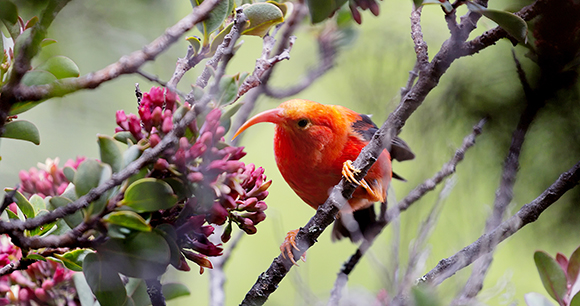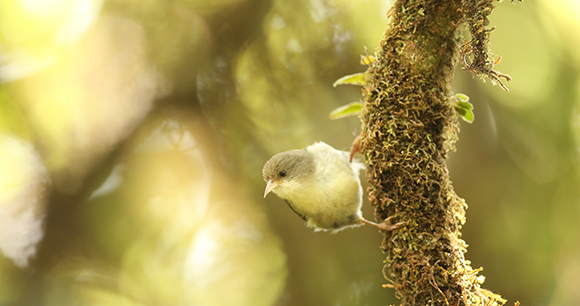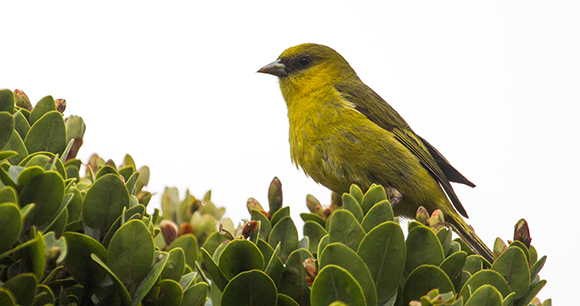by Chris Farmer, PhD, Hawai‘i Program Director, American Bird Conservancy, and Lisa “Cali” Crampton, PhD, Project Leader, Kaua‘i Forest Bird Recovery Project
The Hawaiian Islands are full of astounding beauty and an incredible diversity of plants, insects, and birds. Most people picture the islands—one of the most isolated archipelagoes in the world—as a tropical paradise. However, Hawai‘i’s wildlife and ecosystems have suffered tremendously from invasive species, as well as habitat destruction and degradation, particularly in the lower elevations where most people live. The majority of plants and animals in these lowland regions are non-native: they arrived with humans and displaced native Hawaiian species.

Hawaiian birds—particularly the honeycreepers, a group of small, brightly colored birds—have been devastated by non-native species. Hawaiian honeycreepers are found nowhere else in the world, and are critical components of forest ecosystems and Hawaiian culture. They are internationally renowned for their incredible diversity of bills, foraging styles, and plumage (greater diversity even, than that found in Darwin’s Galapagos finches), which occurred after their arrival in Hawai‘i approximately 5.7 million years ago, when the oldest of the main Hawaiian islands, Ni‘ihau, was forming.
Over 115 endemic bird species thrived in Hawai‘i before humans arrived, with whole groups that are now absent, including moa-nalos, flightless rails, stilt-owls, and a blind mole duck. Since human colonization, at least 71 bird species in Hawai‘i have become extinct. Historically, at least 57 species of honeycreepers filled Hawaiian forests from the sea to the mountains with their songs. Today, only 17 honeycreeper species remain, many of them on the brink of extinction. Eleven are listed as endangered or threatened under the US Endangered Species Act, and the International Union for Conservation of Nature lists 15 as vulnerable or worse.
The biggest threat to the honeycreepers’ survival is introduced diseases—specifically, avian malaria, which is transmitted by non-native southern house mosquitoes. This mosquito species arrived in 1826 and quickly spread across the islands, while avian malaria reached Hawai‘i in the early 1900s. A wave of honeycreeper extinctions soon followed. Most honeycreepers have no resistance to the disease, so one bite from an infected mosquito can be enough to kill some birds—such as the iconic ‘i‘iwi, with its brilliant scarlet feathers, black wings, and long, salmon-colored sickle bill. Both mosquitoes and the malaria pathogen require warm temperatures to reproduce, so their range has historically been limited to the lowlands (a.k.a. the mosquito zone), while most honeycreepers found refuge in cooler, high-elevation forests. The high mountains of Kaua‘i, Maui, and Hawai‘i provided significant forested area above the mosquito zone and therefore retained many of their native birds, while the lower islands tragically did not.

Unfortunately, the mosquito zone has been expanding because of increasing regional temperatures due to global climate change. Now, these invasive insects are present year-round in many formerly safe Kaua‘i and Maui forests, and honeycreeper populations are crashing as a result. Without action, the ‘akikiki and ‘akeke‘e on Kauai and the kiwikiu and ‘ākohekohe on Maui are likely to go extinct in the next decade. The ‘akikiki is at greatest risk—it could vanish within two years. From 2015 to 2021, the number of ‘akikiki breeding pairs in the core of their range decreased from 35 to 1, and the entire wild population is now estimated at fewer than 76 birds (and likely closer to 45). Soon, the rest of the honeycreepers—including those on Hawai‘i Island, where higher mountain forests have provided more protected, disease-free areas—will suffer the same mosquito-driven population collapse seen on Kaua‘i.
Yet there is hope, because we have the ability to save these irreplaceable treasures of cultural and biological diversity. Birds, Not Mosquitoes (BNM), a collaboration of over 20 state, federal, and nonprofit partners and dozens of individuals, is working to deploy what is known as an “incompatible insect technique”—a form of mosquito birth control that conservation practitioners and agency biologists agree is the most promising approach to suppress mosquito populations and save these native birds. It involves a very common, naturally occurring bacteria, Wolbachia, that affects mosquitoes’ ability to reproduce. For mosquitos to produce viable eggs, both the male and female must carry the same strain of Wolbachia. To control populations, scientists will rear males that carry a different strain of the bacteria than is found in wild mosquitoes, then release the lab-reared mosquitoes into forests in Hawai‘i. Male mosquitoes do not bite birds (or people!), but very effectively find and mate with wild females. Because the bacteria strains are incompatible, females mated to lab-reared males will lays eggs that do not hatch. After several releases, the mosquito population will decline due to this lack of successful reproduction.
Millions of lab-reared males would be released to outnumber the wild males and increase the likelihood that incompatible males will mate with the wild females. Population suppression would be achieved by repeating this weekly or monthly, depending on the situation. Because mosquitoes are such recent arrivals to Hawai‘i, none of the native species depend on them, so removing them should not significantly impact food webs. Mosquito birth control was originally developed and deployed to control diseases affecting humans, and this safe and proven technique has been used to suppress various mosquito species worldwide, including in Fresno County, California, and Miami-Dade County, Florida.
BNM is building upon that investment and research to launch the first application of this mosquito suppression method for wildlife conservation purposes. We are working on all components of this project to advance it as quickly as possible. Wolbachia mosquitoes are regulated as a biopesticide by the US Environmental Protection Agency and the state Department of Agriculture. We are securing the required permits, completing the necessary environmental assessments for Kaua‘i and Maui, and conducting extensive community engagement about this project across the islands.

BNM partners are also researching ways to construct the best implementation plan for location and frequency of releases. The males only live a few days and do not reproduce, so many releases each year will be needed to maintain protection of the birds’ habitat from the remnant wild population and any female mosquitoes that move into the forest from the lower elevations. While this does increase the costs, it also means the process is reversible, and if there are unforeseen consequences, stopping the releases will allow the system to return to its previous state. The current timeline is to begin field tests and pilot releases in 2023, and effective landscape-scale control of mosquitoes in 2024. Although complicated, all these individual steps have been done elsewhere, so we are confident we can combine everything to save our honeycreepers.
AWI is a key part of BNM’s strategy to save the Hawaiian honeycreepers from extinction and has provided support for Kaua‘i Forest Bird Recovery Project surveys to better understand mosquito distribution. This will help BNM determine release frequency and locations, monitor and assess mosquito population reductions, and adaptively adjust deployment once started. AWI has also supported the American Bird Conservancy’s community engagement activities. The mosquito birth control project will be an extensive management action on multiple islands, using a technique new to Hawai‘i. Because honeycreepers are uncommon to extremely rare and found in remote areas, most people—even those who live in Hawai‘i—are unfamiliar with them. Inspiring people and connecting them to the need to save these species is critical to building the public support necessary for the project to succeed.
The success of this project will prevent additional extinctions of Hawaiian birds and help populations of these birds to rebound, providing opportunities for everyone to see and experience these precious beings of the Hawaiian Islands.
How YOU can help
- Learn more and stay informed:
- Help KFBRP with remote projects (kauaiforestbirds.org/volunteersinternsstudent):
- Sorting photos
- Entering data
- Making bird bags
- Spread the word by sharing with family and friends
- Address climate change
- Conserve energy by driving less, riding your bike, using energy efficient vehicles and appliances, and turning off the lights
- Reduce, reuse, and recycle
- Invest in carbon offsets
- Shop wisely. Choose products that are energy efficient, durable, made from sustainable sources, and sustainably packaged
- Engage policymakers and let them know you support policies that protect endangered species and mitigate climate change, and vote for candidates that support these policies
- Practice good biosecurity—when traveling between different habitats or islands, clean your boots and gear of mud and seeds
- Support nature-friendly causes with your time and donations